Iguazu Falls in the North of Argentina is a chance to witness nature’s grandeur and fury up close.
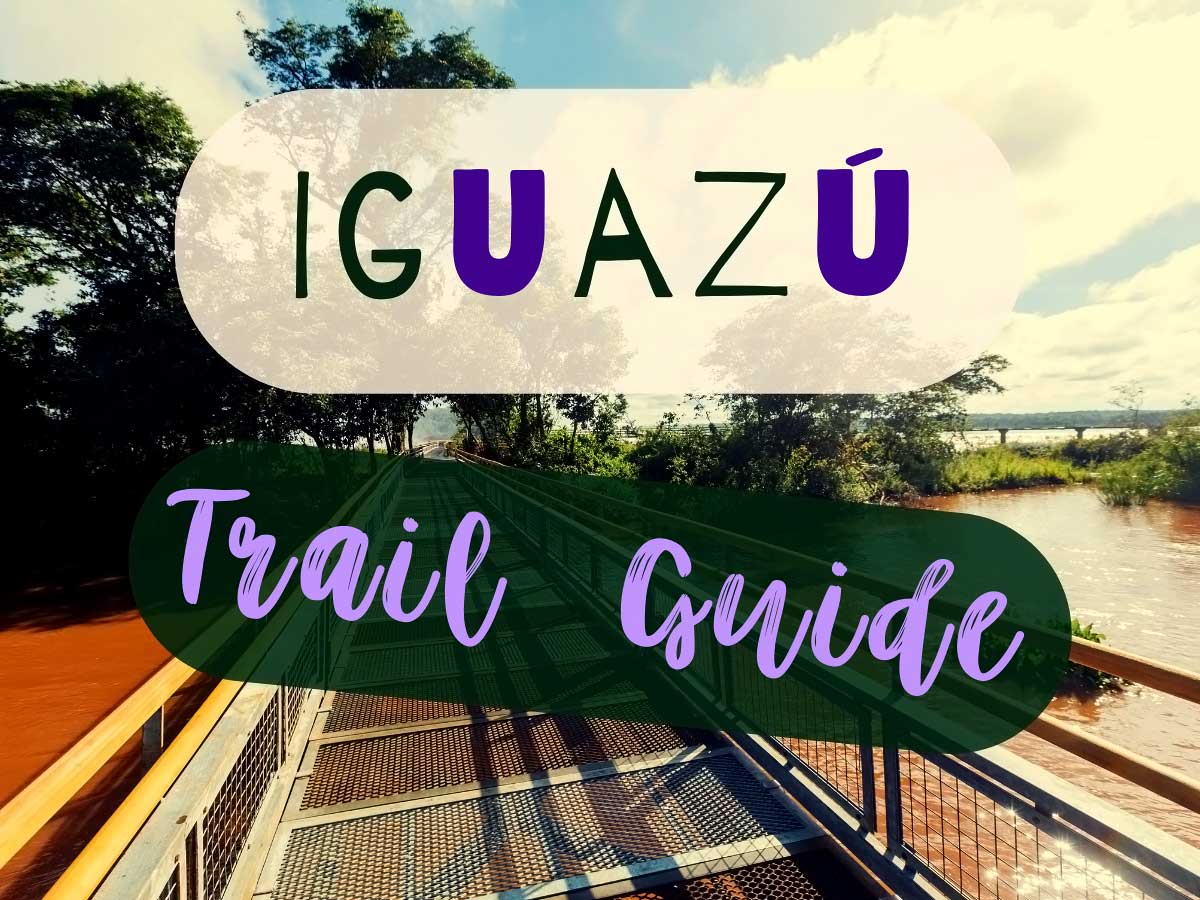
The largest waterfall in the Americas spans over 2.7 kilometers of the river’s edge.
It forms a semi-circle of 275 individual waterfalls with water rushing down at an average of 1,756 m3 per second.
At Iguazú Falls there is a majestic sparkle in the air, as if you’ve stepped into the scene of a fairytale.
Rainbows are everywhere at Iguazú
Rainbows at Iguazu Falls connect Naipí and Tarobá of local Guarani myth.
The sun dances off the water pouring over the fault’s edge, casting rainbows throughout the air and dusting the vivid greenery with a diamond-like shimmer.
- Argentina no longer requires visitors to have proof of vaccination or a Covid test before entering the country, see Visiting Argentina for more detail.
- Due to a landslide some parts of the park are temporarily closed
- Water levels in the rivers are low, so aquatic tours are limited
- It is now temporarily required to have a guide when visiting Iguazu Falls National Park.
- A knowledgeable private guide can be arranged with our flexible two or three day Iguazu Falls trips. Arranging a lower cost group tour online will suffice as well.
About Iguazu Falls
One of Argentina’s top tourist attractions, Iguazu Falls was named an UNESCO World Heritage site in 1984. In 2011 it was named one of the Seven World Wonders of Nature.
The Spanish name for Iguazu Falls is Cataracas de Iguazú.
Iguazu Falls National Park (Parque Nacional de Iguazú) is a 67,000 hectare park.
Formed in 1934, it was the first national park formed in Latin America. The sister park across the border in Brazil, Iguaçu National Park was formed four years later.
The parks are set in the lush Atlantic Forest, the second most important rain forest in Latin America, after the Amazon Jungle.
The Atlantic Forest is 90% deforested, so much of the flora and fauna seen in this area are unique and endangered species.
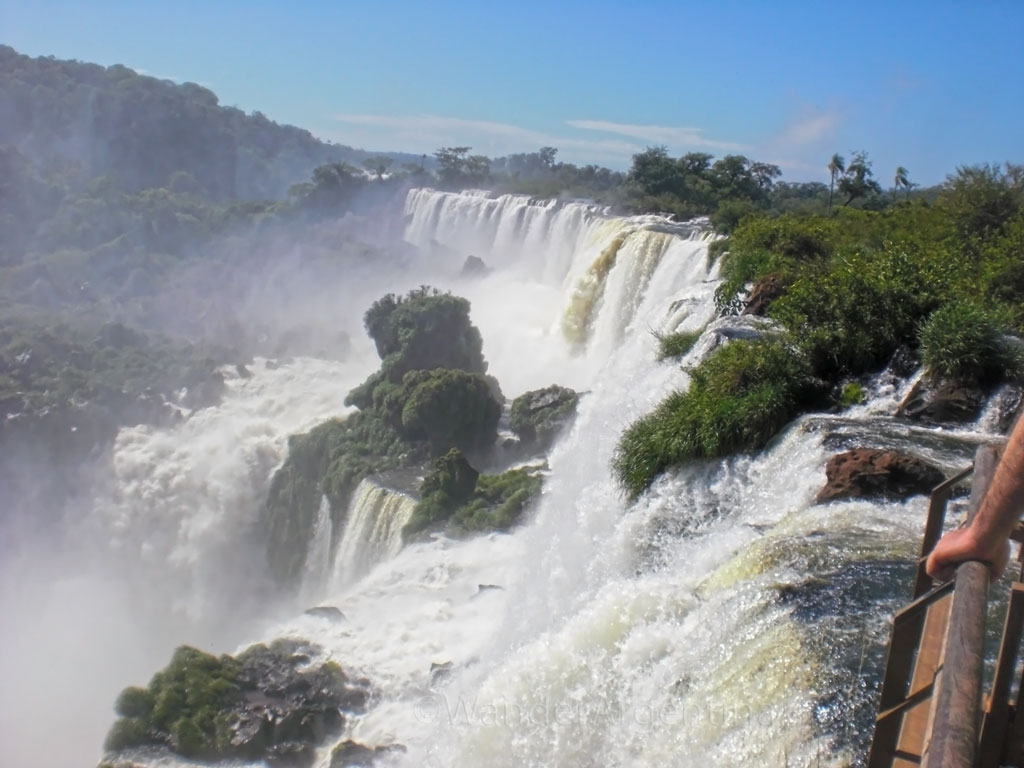
The Upper Iguazú River drops 82 meters at the pinnacle of the cataracts.
Its largest fall, La Garganta del Diablo (The Devil’s Throat) feeds into Lower Iguazú, collects in a canyon, and then flows into Argentina’s Paraná River.
Upon arrival, the surreal beauty of the jungle and waterfalls are masked by the imposing visitor center structure where tickets are purchased. Two rooms here explain the ecosystem and biodiversity of the park and information about the original inhabitants, the indigenous Guaraní.
Get an early start at the national park and try to stay ahead of groups of tourists on guided tours who populate the paths.
Several languages can be heard along the busiest part of the trails, a testament to the worldwide reputation of one of Argentina’s top tourist attractions.
There are plenty of paths to walk and passing others is as easy as just picking up pace and scooting by.
Iguazu Falls Walking Trails
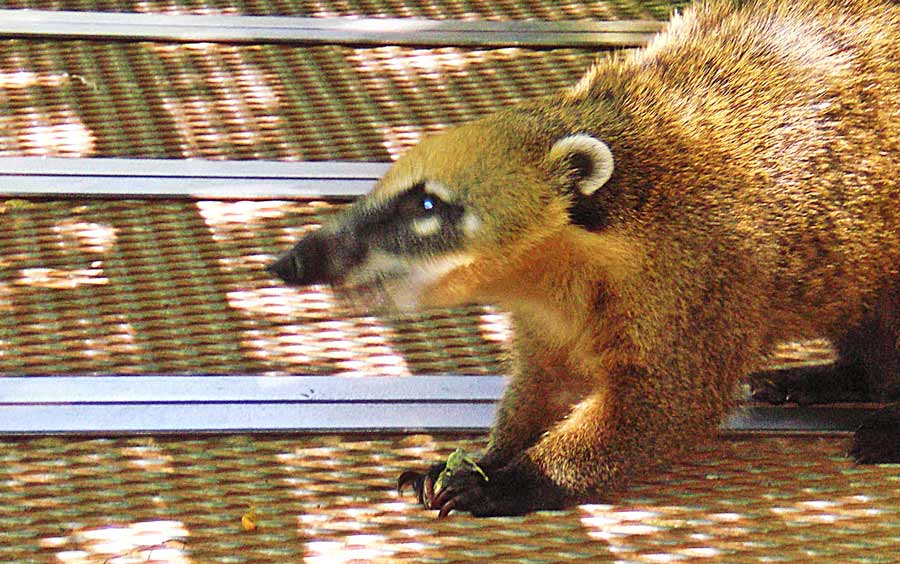
Those who prefer to keep their feet on the ground will find plenty of walking trails at Iguazu that provide breathtaking views.
Standing on the fault’s edge is a vertigo-inducing sensation offset perfectly by a refreshing mist giving relief from the humidity.
Along these walkways are packs of Coatis, or Brazilian aardvarks, that feed on stray berries and pose along the railings for snap-happy tourists.
Be careful, they will steal a snack if given the opportunity but the park asks visitors not to feed them.
The fast and and skillful flying Cascade Swift (Cypseloides senex) is the official emblem of Iguazu National Park. The brown and grey birds form huge flocks that are seen early hours, when they leave to look for food, and in the evening, when they return to their roosts.
Coatis are the most common but not the only animal seen in the park. There are also caí monkeys, gray squirrels and more than 450 species of birds, such as toucans, noisy magpies and jotes.
There are also an estimated 35 jaguars in the national park, which only the most privileged visitors get to see (most likely those staying in one of the two hotels in the park because they are most likely to be spotted at dawn or dusk.)
Green Trail
Train Stop: Central Station
Accessibility: High
Difficulty: Low, without stairs.
Duration: 15 minutes
Distance: 600 meters
Welcome to the jungle! The Sendero Verde or Green Trail is a short easy footpath taking visitors immediately into the canopied vegetation and the exotic sounds of the rainforest. It ends in a little plaza where the lower and upper circuits begin.
The Lower Circuit Trail
Train Stop: Cataratas Station
Accessibility: High
Difficulty: Low, without stairs.
Duration: 1:15 hours
The Lower Circuit of Iguazu Falls takes roughly one hour and 15 minutes to traverse, hosting 150 meters of stairs.
The moderate effort it takes to arrive hiking is more than made up for with face-to-face encounters with five different waterfalls.
The lower circuit is ideal to conquer at the end of the day. Once the crowds have dispersed visitors will feel they are discovering the falls for the first time.
One highlight is Dos Hermanas (Two Sisters), tucked away in a quiet crevice. The peacefulness of the trail at dusk becomes hypnotic with the Two Sisters’ synchronized pitter-patter on the pool below.
A diverse mix of walkways and jungle paths make it likely to spot several of the different species of birds resting in treetops. Most commonly seen birds are the boomerang-like swifts (the park’s official symbol) and colorful parakeets and parrots.
Iguanas and lizards also scurry across the trails, but perhaps the most inspired picture comes from the swarms of vibrant butterflies that land on the limbs of passers-by.
The Upper Circuit Trail
Train Stop: Cataratas Station
Accessibility: High
Difficulty: Low, without stairs
Duration: 35 minutes
Iguazu National Park’s upper circuit trail is a1200 meter walk, completed in roughly 35 minutes.
This short course boasts some of the most impressive panoramic views that can be enjoyed from the Argentine side and highlights the vast expanse of the Brazilian border.
Various lookout points at the peak provide views of several cataracts, starting with Bossetti Fall – named after an explorer who ‘rediscovered’ the falls in the late 1800s.
The upper circuit trail finishes at the Mbiguá Fall, a black cormorant aquatic black-colored bird with a yellow beak.
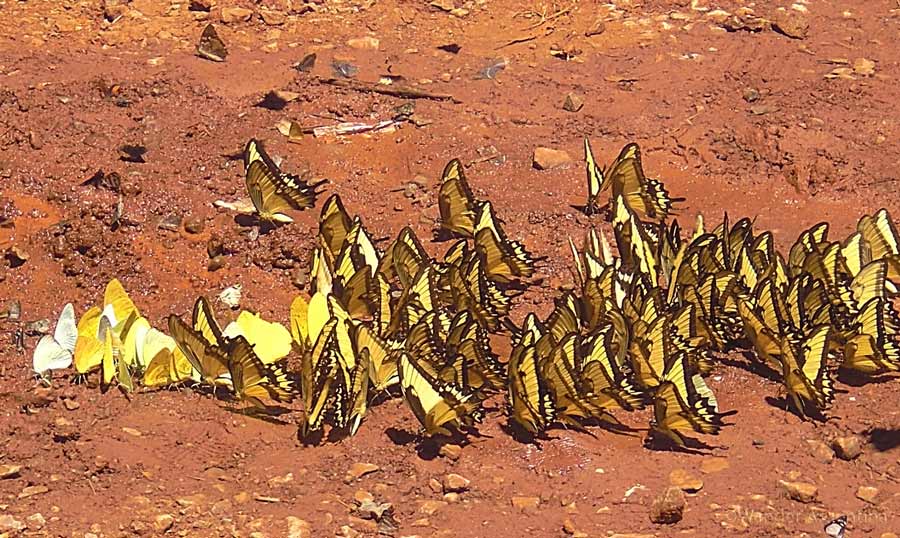
Macuco Trail
Train Stop: Central Station
Accessibility: Low
Difficulty: Low to high, depending on route
Duration: Three hours
The Macuco trail is 3.5 km (2.2 mi) the longest and wildest of the jungle paths at Iguazu National Park.
The trail is an hour-long adventure into the jungle on a peaceful path full of exotic birds and bountiful butterflies.
The end point of the trail is Arreachea Falls, a 23-meter high drop into a beautiful crystal cerulean pool that will tempt swimmers.
Weather and time permitting, spending a few hours at this blue lagoon isn’t a bad idea.
The Devil’s Throat Trail
Train Stop: Garganta del Diablo Station
Accessibility: High
Difficulty: Low, without stairs
Duration: Two hours
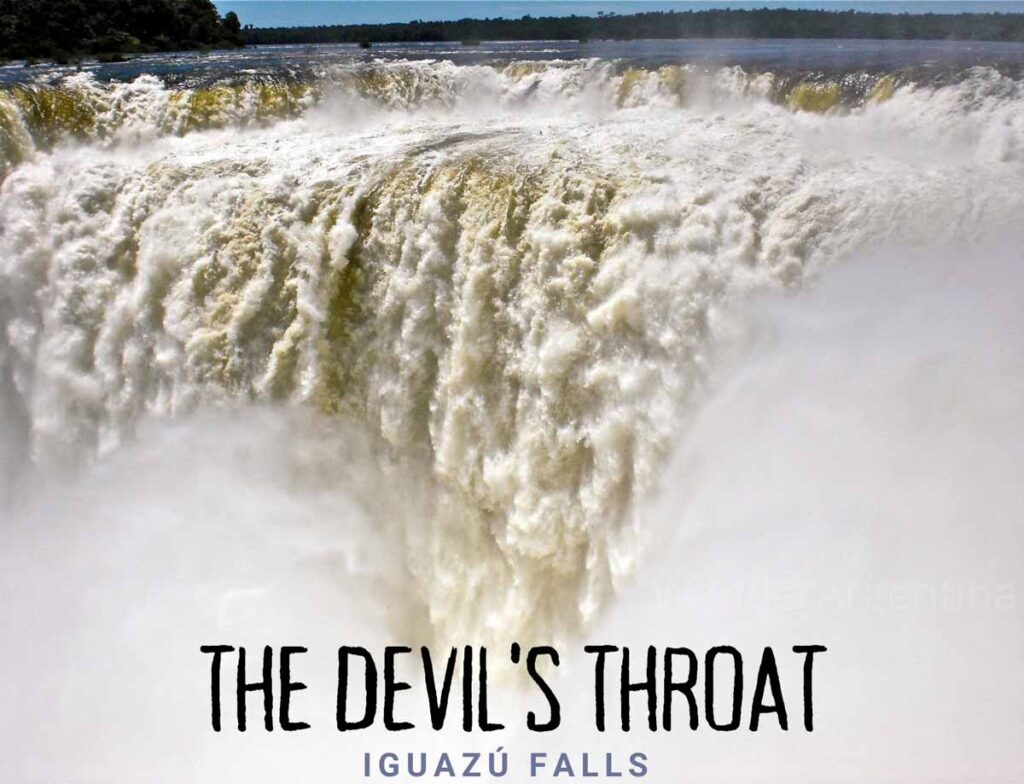
The Devil’s Throat Circuit which takes visitors to the largest waterfall at the park, La Garganta del Diablo is the highlight of the trails at Iguazu.
At Devil’s Throat, the thunder of the river breaking over the banks is hypnotic.
If the Devil’s Throat Fall is the conductor, the neighboring cascades are the orchestra, keeping perfect rhythm with the water gushing at an average 62,000 cubic feet (1,756 cubic metres) per second.
The railing is the only thing holding you back from certain death, but this unrestricted access liberates the onlooker and makes the crowd disappear into the background.
Adding to the devilish drama are the swarms of turkey vultures menacingly circling overhead, as if bidding their time until someone falls to their death.
Leave at least an hour to for this trek, because unlike the other paths with several vistas, there is only one balcony area to get a good view of the falls.
Rainforest Ecological Train
Accessibility: High
Stations: Central, Cataratas and Garganta del Diablo.
Distance: 14 km
Duration: 25 minutes
All trails throughout the Argentina Park are connected by the Rainforest Ecological Train (Tren Ecológico de la Selva), which facilitates access to each part of the park with three different stops along the way that provide access to the Lower Trail, Upper Trail and The Devil´s Throat.
The locomotive is powered by liquefied petroleum gas for low-ecological impact.
It is a narrow-gauge train, like the Old Patagonian Express, especially designed for tourism.
The slow-moving train produces little noise in order to reduce disrupting wildlife, while allowing visitors close contact with nature in the open wagons.
From Central Station, one can either take the jungle train or walk the Green Trail to Cataratas Station, which marks the beginning of the Upper Circuit.
From Cataratas Station, the train travels deep into the forest, explores different branches of the Upper Iguazú and ends at the Devil’s Throat Station, where the Devil’s Throat Circuit begins.
Use of the Ecological Train is included in the price of tickets. The beauty of the train is that it is adapted for wheelchairs and baby strollers, so people of all mobility levels can see the highlights of the national park.
Aquatic Tours in Iguazu Falls
Aquatic tours are one of the most exciting ways to explore Argentina’s National Park and for thrill seekers they are the highlight of their Iguazu journey.
The Great Adventure Tour, the most daring and longest offering, includes a 4×4 safari tour of the Yacaratiá Trail, the longest trail in Iguazu National Park. The heart of the dense, subtropical jungle explored is home to 2,000 species of plants, 450 types of birds, 80 mammals and the countless exotic insects.
Along this eight kilometer safari ride you may see snakes crossing the trail, Capuchin monkeys swinging between trees, huge spiders spinning their webs in the branches and Red-Breasted Toucans perched in the treetops.
The bilingual guide points out the edible trees that line the dirt path and explains how hearts of palm are extracted from the numerous Palmetto trees in the jungle.
The jungle safari concludes near the water’s edge, where rafts are wait to load visitors to traverse the Lower Iguazú River.
After a six kilometer cruise on lower Iguazu showcasing some of the smaller falls, the current picks up and boats are thrown into two kilometers of rapids.
There’s a white water close encounter with the mouth of The Devil’s Throat, a drenching beneath the Dos and Tres Mosqueteros (Musketeer Falls), and San Martín cascades.
The finale leaves passengers soaked yet awed by the exhilaration of having faced the fury of the falls. The water quells the heat and one cannot resist the urge to gaze upwards to receive a bath by Mother Nature.
A final stop on San Martín Island, a paradise with a white sand beach that sits at the heart of the cataracts.
If you book one tour on the Argentine side of the falls it should be the Gran Aventura Boat and Argentinian Falls Tour which includes hotel pickup.
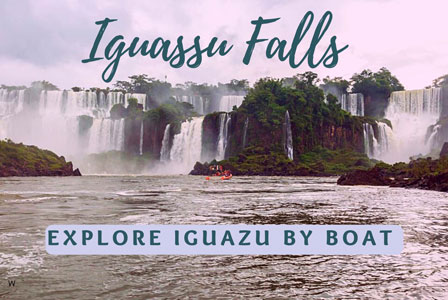
Liven up a visit to the Brazil side of Iguazú Falls with an up-close visit to the Devil’s Throat by pontoon boat
Local Legends about Iguazu Falls
The local name for the falls is Chororõ Yguasu or ‘Great Waters.’
It was given by the indigenous Tupi-Guarani people, who used to roam these river banks.
The Guarani people are spiritual and their traditional religion is animistic.
As the nearby Jesuit missions ruins attest, many were at least partially converted to Christianity but Guaraní folk tales live on and typically change with every telling.
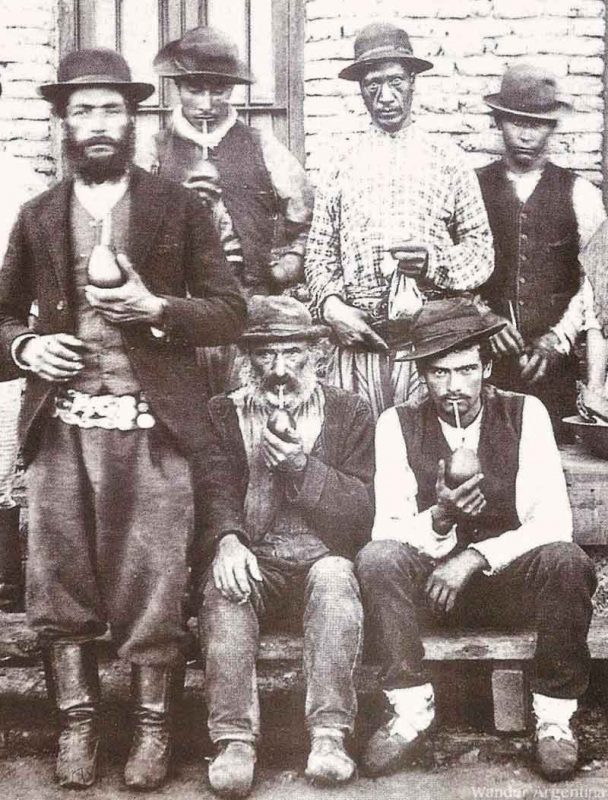
The Guaraní People and Yerba Mate
Did you know that the idiosyncratic custom of Argentines to drink yerba mate came from the Guaraní people?
They were the first to cultivate the shrub and make drinking the infusion a regular social occasion.
They worshipped the plant for it’s ability to increase stamina and stave of famine.
Read about the health benefits of Argentina’s favorite vice ➡
Guaranis explain the massive phenomenon of nature that is Iguazu Falls with mythological tales of love and rage.
The most common legend, told many different ways, is a mystic Romeo and Juliette-like tale.
It says the waterfalls mark the spot where a beautiful woman was sacrificed every year in order to tame a vicious snake diety Mbói Tu’i who inhabits the waters of Iguazu River.
One year Tarobá, a brave Guarani warrior learned that a young beautiful woman from the neighboring village, Naipí was about to sacrificed to appease Mbói Tu’i.
The night before the ceremony, under the darkness of a waning moon Tarobá navigated the waterways by canoe and escaped with the young woman, so she could live and they could hide away together in secret forever.
The evil serpent creature grew angry and burst, contorting his body and splitting the river in half out of fury, forever separating the couple with the largest series of waterfalls on earth and condemning their spirits to eternal life.
According to local lore, Naipí was turned into a palm tree on the Argentine side of the falls. Tarobá was petrified into a large stone that lay beneath the falls, forever punished by water.
The waterfalls are their never-ending tears. The ethereal bond between them is manifested only in the frequent rainbows that connect them.
Food in Iguazu National Park
There are restaurants, which have pizza and other basics, near the entrance of the park, but expect the usual tourist hotspot offerings of overpriced, mediocre food.
There there are fast food options near Central Station and Devil’s Throat Station, useful for the bathroom facilities and places to sit and regroup and relax.
A better bet for those dining at the park with the whole family is the buffet and grill Fortin Cataratas located on the upper circuit.
Packing your own picnic is a less expensive option if weather permits.
On the Brazilian side of the falls after getting wonderful panoramic photos there’s not much else to do.
Also on the Brazilian side is Restaurante Porto Canoas offers a similar buffet and grilled meat set up with a spectacular view of Devil’s Throat.
Full Moon Tour & Dining Experience
The ultimate dining experience in Iguazu National Park is the once-a-month full moon tour to the Devil’s Throat.
Nothing can beat seeing one of nature’s most spectacular wonders under a night sky illuminated by the full moon.
This tour provides a chance for visitors to see the daytime shimmer of the landscape replaced with serene silver and blues of the falls at night.
The excursion starts with a ride to Garganta del Diablo Station – and all the while hearing the wild symphony of the jungle at night.
Then moon walkers cross the Iguazu River over the footbridges to arrive at Devil’s Throat Balcony.
A three-course dinner with a choice between three entrees is served at L Selva restaurant.
If planning to visit Iguazu around the full moon, this tour is essential, but it fills up fast.
A local travel agency with contacts in Iguazu may be your best bet to secure tickets but you can also try to book online, unfortunately you will pay double if using a foreign credit card.
Puerto Iguazu Town
Puerto Iguazu is the closest town to Iguazu Falls and it exists only for the tourist sector. Most visitors who travel here to see Iguazu Falls stay in this modest pueblo 18 km (11 mi) from the national park.
Puerto Iguazu is 20.6 km (12 mi) from Cataratas del Iguazú International airport. There are regular shuttle to town, or you can arrange private pickup.
It has more than tripled in size the last twenty years, becoming the fourth largest city in Misiones province. It still has well under 100,000 though, so it’s easy to navigate.
The surrounding tri-border area also contains Foz do Iguazú (Brazil) and Ciudad del Este (Paraguay).
Puerto Iguazu Town Attractions
Puerto Iguazu doesn’t have much in the way of attractions itself as it is just a service town but it’s worth a walk to the river’s edge at the northwest corner of town to see where the borders of Argentina, Brazil and Paraguay meet.
The tri-border area is known as the Hito Tres Fronteras (Three Borders Milestones or Triple Frontier), which is the point where the limits of Paraguay, Argentina and Brazil come together.
There is a mini obelisk (similar to the Obelisk in Buenos Aires) for each of the three countries.
There’s a plaza and lookout point where the three countries meet and the Iguazu river joins the Parana river. There’s sometimes a craft fair and locals come to hang out to drink mate.
Iguazú Falls Nearby Attractions
Misiones province offers visitors a number of interesting sites in close proximity but travelers only really need two days to see the waterfalls — one day in Argentina and a half a day in Parque Nacional do Iguaçu in Brazil.
Those who love bushwalking or have interest in other local attractions, can take three or four days to have the ultimate Iguazu Falls experience.
Many travelers stay in Puerto Iguazu rather than Foz do Iguazú since Argentina is less expensive.
Almost everyone also does a half-day hop over to border the Brazilian side of the national park for a tour to enjoy the panoramic views of the falls.
Ciudad del Este, Paraguay
Ciudad del Este (Eastern City) in nearby Paraguay is known as a shopping mecca for Argentines and Brazilians because there are a lot of free trade (read black market) products which are typically expensive in these countries due to import taxes.
The city’s freewheeling commerce has attracted a sizable Chinese, Arab and Indian population since the 1980s when the hydroelectric Itaipu Dam brought more development.
For the past few decades the Triple Frontier and particularly Ciudad del Este, the area’s largest city, has been implicated in funding international organized crime.
Whatever lawless movements are going on behind the scenes, it doesn’t of affect the safety of tourists, but admittedly few stay here after nightfall.
Wanda Mines
Those with an into geodes and amatists could also visit Wanda Mines, an amethyst mine an hour to the south.
A tour here is often done in conjunction with the intriguing San Ignacio Ruins nearby.
San Ignacio Ruins
There are also a cluster of Jesuit ruins dating to 1610 about 100 km south of Iguazu National Park.
San Ignacio Miní, Reducción de Nuestra Señora de Loreto and the Guarani Jesuit mission of Santa Ana are all in close proximity.
The extensive, well-maintained ruins demonstrate the wealth of the clergy who came here to convert the indigenous here 400 years ago. Much of their wealth was built cultivating yerba mate on plots for the first time.
Those who choose to rent a car for the excursion can also cross over to Paraguay to see more ruins nearby.
Iguazu Falls Climate & Best Time to Go
Wondering when the is the best time to go to Iguazu Falls both climate-wise and crowd-wise?
Iguazu Falls has temperate weather for most of the year. In summertime it is hot and muggy, so those who dislike 32+ temperatures will want to avoid late December and January, the hottest month.
Argentina’s summer holidays are from Christmastime until Carnival at the end of February so these are also peak months for internal tourism.
In the winter months of June, July and August it does get down to 10-13 C (50-55 F), with it getting the coldest in July, so a jacket will be needed at night — the trade-off is less crowds.
Iguazu Falls is also popular destination for Argentines and other Latin Americans around during Semana Santa, or Easter week.
The weather is perfect in April, but a trip during Easter week will mean lots of crowds.
Any other week in April, or the months of March or May promise decent weather and less people coming between you and the Devil’s Throat.
October is the month with the most rainfall, so the waters roar at Iguazu and the temperature is pleasant.
November, before the height of the summer season, is when it’s less rainy and the flowers are blooming.
It is absolutely lovely in November but with the blue dollar strong and the secret being out about how November is the best month to visit Argentina, crowds are inevitable.
Iguazu Falls Checklist
- Expect to get wet — pack clothes with synthetic breathable fabric that dry quick
- Don’t forget a bathing suit in the summer and winter if your hotel has an indoor pool
- Sunscreen, sun hats and sunglasses
- Mosquito repellent. This area does have Dengue Fever, but not to the levels of other Latin American countries
- Good walking shoes — there are slippery areas on the walkways and visitors do a lot of walking, so wear comfortable walking shoes or sport sandals.
- Visitors planning to return the park for a second day should make sure to get the tickets stamped by park rangers on the way out because admission on day two is discounted.
- To get all the action you’ll want a durable, waterproof camera like a nifty GoPro 10. Even waterproof videocameras like this one that shoot underwater high definition footage are under $200.
- Large waterproof ziplock baggies or a waterproof nylon travel bag for any other non waterproof items such as watches and phones. The boat tour companies provide waterproof pouches but the zip-close plastic bags add extra security against splashes or rain.
- Before traveling to Iguazu, double check entry requirements and conditions because there are liable to change
—Parque Nacional Iguazu’s official webpage
—Parque Nacional do Iguaçu
→ Cont. Getting to Iguazu Falls & Lodging
